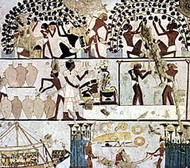How the Ancient Romans, Chinese, Egyptians and Others Stayed Cool
How the Ancient Romans, Chinese, Egyptians and Others Stayed Cool
Posted by Josh H on 2nd Feb 2021
Air conditioning is one of those incredible inventions that we in the modern world don't pay too much attention to, except maybe in its absence. We take it for granted that no matter how hot and brutal the summer is, we can find somewhere cool to escape the heat; be it our homes, our cars, or even the local grocery store, there is nearly always a place nearby with some of that wonderful air conditioning where we can cool our collective heads and chill out. However, if one stops and considers beyond how easy and accessible air conditioning is in our time, an interesting question might come up: how in the hell did people stay cool before the A/C unit came along?
Like the stories of many of history's most interesting and useful inventions, it all starts in Egypt. Unsurprisingly, the Egyptians needed to find some way to escape the incredible heat; their average summer temperature even now is usually around 104 degrees Fahrenheit, though it often spikes up past 120! To combat this, the ancient Egyptians would take mats of woven reeds and wet them down, then hang then on the windows; the breeze blowing through them cool down, would then providing some relief from the heat. This is actually the first historical example of evaporative cooling, something those of us with swamp coolers have experienced firsthand: air is passed through moisture, which absorbs the heat present, and then continues on at a lower temperature.
From Egypt, we go north into the so called “Cradle of Civilization”, ancient Mesopotamia; specifically, the Persian Empire. In ancient Persia, clever engineers figured out ever more ingenious ways to cool everyone down. Their method was to use specially designed towers with open faces, called malqaf, or windcatchers, to direct prevailing winds into underground pools for collecting and storing water called qanat, or cisterns. The water would cool the air, again using the principles of evaporative cooling, and proceed on into various attached buildings, giving the Persians the much beloved cool and comfortable rooms they would need to invent things like advanced geometry and trigonometry, and that most hated of high school subjects, the dreaded algebra. Luckily, they also invented coffee, which takes the sting of of their math-related transgressions, at least for this writer. Thanks Persia!
To the west of Persia, the ancient Romans were also doing some solid work with evaporative cooling. The Romans used one of their other great constructions, the mighty aqueduct, to give themselves some respite from the muggy Italian summers. The channels, or sluices, that diverted water into Roman homes were also designed to run through the walls of various rooms throughout the building, keeping the temperature down and making it so they could hand around in their fancy togas and come up with things like a standardized counting system, the first bound books, and the postal service.
To close out our air-conditioned tour of the ancient world, we're going to take a direct u-turn from Rome and head east to that bastion of ancient technology, China. While the rest of the ancient world was messing around with evaporative cooling and architectural features to direct wind into somebody's living room, the Chinese took a different approach altogether, thanks a particularly clever fellow named Ding Guan: the generated their own wind. Ding Guan was an inventor in the first century BC, and he came up with the next integral part of the air conditioning system: the fan. Now, handheld fans had been in use all over the world for centuries, if not millennia, but Ding Guan took it a step further, and came up with bladed rotary fans. His design called for a fan nearly 10 feet across, and manually powered by prisoners. Nearly a thousand years later, his invention was still in use, though greatly improved. The Emperor Xuanzong of the Tang Dynasty had a special hall in his castle, called the Cool Hall, or Liang Dian, that was powered by water jets from fountains instead of by hand; much the relief of some unlucky servants, no doubt.
So next time you fiddle with the thermostat to get that comfy inside temperature just right, spare a thought and a thank you for those clever and industrious ancient folks who made the basics of air conditioning possible; and maybe raise a (coffee) cup in salute.

